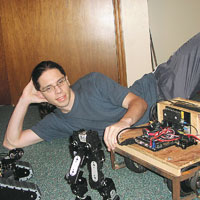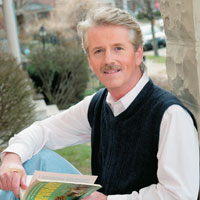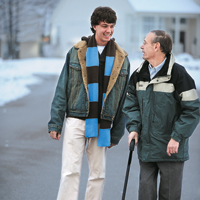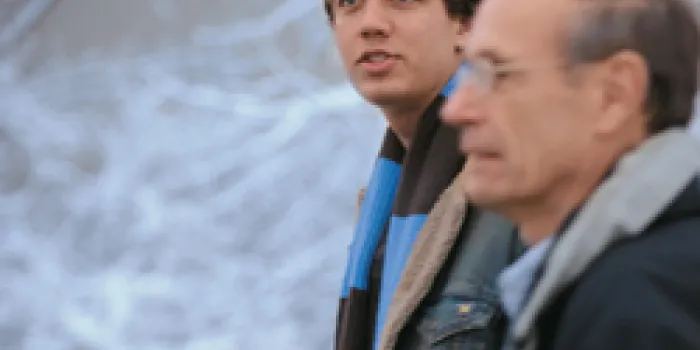For Mike O’Connor, attending college as a young man with hemophilia in the late 1970s and early 1980s meant forging his own path. There were few older men with hemophilia to turn to for encouragement, help or advice. “When I was born, the life expectancy of a man with hemophilia was 41 years old,” he says. “I didn’t get to talk to older men with hemophilia because they just weren’t around. That generation was gone.” O’Connor, 48, a retired radiation oncology physicist now living in Tempe, Arizona, is vice chair of the Board of Directors of the National Hemophilia Foundation (NHF).
People with bleeding disorders today are living longer and aging better. The older generation that was missing for many men who came of age with hemophilia before the 1980s is beginning to manifest itself. The baby boomers, Generation X and Generation Y are discovering some common bonds among themselves—the value of community, story sharing and how much they need each other.
Seeking Community
“Community was always important to me,” says O’Connor, who was diagnosed with severe hemophilia A when he was 4 months old. Growing up in a small town in Minnesota, he did not know another boy with hemophilia. Trips to the Mayo Clinic in Rochester, Minnesota, for appointments with his hematologist meant seeing other families, but not knowing if they had a common bond. “In the ’60s and ’70s, the philosophy was confidentiality,” O’Connor says. “I sat in the hematology waiting room and wondered, ‘Gosh, does that kid have hemophilia?’ But I’d never dare ask.”
As a young boy, O’Connor lived a fairly sheltered life, he says. He was not allowed to crawl as a baby. When his siblings went off to summer camp, he had to stay home. At school he was known as “Little Mike,” the boy with hemophilia. And he admits that his mother hovered over him. “How many people with hemophilia does it take to change a light bulb?” he jokes. “None, they get their mothers to do it.”
[Steps for Living: All About Camps]
It wasn’t until he went to college that O’Connor met others with hemophilia and started experiencing a sense of community. “I was looking for others who had what I had so I could figure out what they were doing,” he says.
But then the HIV/AIDS crisis hit the hemophilia community hard—and O’Connor’s community crumbled. “Just when I started developing good, close relationships with some great guys, all of a sudden they started dying,” he says. He attended at least 25 funerals for friends felled by AIDS. O’Connor says that’s when he got angry. “I didn’t want anything to do with the community.”
A job transfer to Phoenix in 1987 gave O’Connor a chance to build a new community. After attending a fundraiser sponsored by the local chapter, the Hemophilia Association of Arizona, he became a board member six weeks later. He served 20 years altogether, six as president. “It was a small hemophilia association, and I knew we had to have programs and services to bring people and families together,” he says.
O’Connor’s local and now national involvement with the bleeding disorders community is fueled by his personal experiences. “I want to do everything I can to make sure other people with hemophilia never have to go through what I went through—HIV, hepatitis C, two liver transplants—and the financial and emotional burdens these bring to the immediate family.”
Although O’Connor didn’t have an older generation of men with hemophilia to interact with during his formative years, he knows how important they are to the community now. He says that one vehicle that can provide opportunities for the generations to connect is NHF’s National Youth Leadership Institute (NYLI). “Annual Meeting provides an excellent opportunity for us to have these young adults in a group and talk to them about what it was like living with hemophilia in the ’50s, ’60s, ’70s, etc. It’s a way we continue our story.”
Keeping the stories alive is important to O’Connor, who is married and has a teenage daughter. He does not want to see history repeat itself in this community. “We have to make sure our future generations know about their history,” he says. “We can’t let that slip through our fingers now.”
Talkin’ ’Bout My Generation
Nick Reiser, 20, of Monroe Township, New Jersey, joined NYLI last year. At his first NHF Annual Meeting in Orlando, Florida, in November 2007, he mingled with some of the older men and heard some of their stories. “I met a few men who were directly involved in lobbying Congress for bills to prevent contamination of factor products,” he says. “It’s great to see how much effort they put forward to make sure that I was safe.”

That’s important to Reiser because his brother Chris, 23, contracted hepatitis C from a contaminated product years ago. “I think our legacy is going to be that we’re the first generation that is free of those diseases—hep C and the like—because the people who contracted them had the courage to step up and say, ‘This won’t happen anymore.’ We’re the babies of that movement.”
Since high school, Reiser has been on a prophylaxis regimen three times weekly to treat his severe hemophilia A. He maintains an active lifestyle, attending college and working part time. A former cross-country and track runner, he still runs and coaches two teams—a track team and a special-education T-ball team.
But he’s aware that the older generation paid a price for his mobility. “I saw guys walking around with canes because they’ve got an ankle that’s so messed up they can’t walk on it properly,” he says. “It’s sad that they couldn’t be helped.”
Inspiration Generation
Gil Ferguson, 62, of Howell, Michigan, a human resources and payroll administrator for a chain of nursing homes, is one of those men. He has walked with a cane for years and has used his share of crutches, especially when he was a child. “When I was a kid, if I got a bleed, I’d try to hold out as long as I could,” he says. He has severe hemophilia A. “I’d put ice on it, a bandage and try to stay off of it.”
When bleeds happened, he hid them. He did not want to burden his father, a widower with three young children trying to make ends meet. “I used to feel real bad. It was a hard life for him.” Inevitably, Ferguson would end up at the University of Michigan Hospital for treatment that lasted up to a week at a time.
When he was in his teens, Ferguson was in a serious car accident. He was thrown through the windshield after his father swerved to avoid an oncoming tractor on a rural road. Ferguson had just left the hospital, where he had received his infusion. Semiconscious, he recalls hearing one of the emergency responders say, ‘Take the man, but don’t bother with the kid. He’s dead.’ Ferguson survived, but spent four months in the hospital, recovering from multiple injuries, including a broken jaw, which was wired shut.
Over the years, Ferguson has persevered through many trials, including an intracranial hemorrhage and brain surgery when he was in his 20s and, most recently, the loss of Lois, his wife of 34 years, in 2006. But Ferguson doesn’t dwell on his problems or his past. His says his faith has sustained him. “I really think the reason I’ve gotten this far is my belief in the Lord.”
Ferguson, a father of two, connects with younger people at the Hemophilia Foundation of Michigan (HFM) in Ypsilanti, his local chapter, and has served on its board. His father, Eldon, helped establish it in the 1950s so that families had a place to talk and share.
The message Ferguson wants to convey to the next generation is simple: “Try to live a normal life. You might have little aches and pains, but keep going as long as you can.”
He’s proud to still be working at his age. “Working is good for your morale,” he says. “It gives you a purpose in life.” He hopes that some younger men might be inspired by him. “I have severe hemophilia—my elbows are stiff and so are my knees. But maybe others see me and think, ‘If this guy can work until he’s over 62, I can do it, too.’ ”
Band of Blood Brothers
For Coy White, 56, the closest his family got to a sense of community were the blood drives they would hold for him when he was a child. “There was no networking of families when I was younger,” says White, who grew up with moderate hemophilia A in Steubenville, Ohio. “We didn’t know any other families with children with hemophilia.”

White, who is married and has a daughter, is a semiretired insurance salesman who now sees generations connect at FAMOHIO (Family Annual Meeting of Hemophilia in Ohio), an annual statewide conference for families and individuals that provides education and networking. White, who also books bands (including the one in which he plays), has served as president of FAMOHIO since 2006 and continues to help plan the meeting.
In 2007, FAMOHIO offered a session called “Just for Men.” It drew older men with hemophilia, younger fathers, brothers and others. The stories they shared were very different, White says. But one message crossed all age categories: You are not alone. “There’s a world out there dealing with this,” White says. “There’s a strange, wonderful catharsis that comes with knowing that.”
Two decades ago White’s role in another support group was entirely different. A hemophilia support group at The Ohio State University Medical Center started out providing a place for sharing among two dozen men who were HIV-positive. As more and more men succumbed to death from AIDS, discouragement and despair set in. White describes himself as a “positive person.” “I was trying to lighten them up and be helpful, but I was running out of gas,” he confesses. “It was becoming a hospice situation.” The group disbanded after a few years.
For White, the men’s session at FAMOHIO 2007 had a therapeutic effect. “It was one of the first times in years that I’ve been able to voice anger, concerns and issues in a private, but shared, voice there,” he says. “It’s like a once-a-year support group that has amazing benefits.”
Founding Fathers
Adam Wilmers, 22, is pursuing a master’s degree in human resource management at Michigan State University in East Lansing. As an NYLI “graduate,” he recalls that at his last meeting in 2006, Ray Stanhope, NHF’s board chair, spoke to the group. “He talked about what it was like for him growing up with hemophilia—the difference in treatment then and how things worked when he was a kid,” says Wilmers, who has severe hemophilia A. “That was a really well-received session.”
 Glenn Triest
Glenn Triest
When he sees older people with hemophilia, Wilmers says he thinks about the struggles they’ve been through and what they’ve accomplished through them. “I appreciate all they’ve done to get our community where it is today—that we have summer camps, for instance,” he says. Wilmers has spent many summers at Camp Bold Eagle in Michigan, most recently as a counselor. “That generation fought for that to happen, and our generation reaps the benefits. They fought for a local network of chapters to support their needs and our needs. We’ve got treatment centers because that generation needed a place to go for hemophilia care. So it’s almost like they’re the founding fathers of everything that has to do with hemophilia today.”
Working with his chapter—he now serves on the board of directors of HFM—Wilmers says that a growing realization started dawning on him. “The older generation wants to connect with us.” To make that happen, the chapter provides opportunities in a variety of ways. One was an alumni dinner scheduled during a teen retreat. “Youth are very interested in the stories of that generation,” Wilmers says.
Phyllis Kandl, MA, of Newark Beth Israel Medical Center Comprehensive Hemophilia Treatment Center (HTC) in New Jersey, says that her role as a liaison between the generations is limited. “We can only give so much advice,” she says. “The younger generation wants to hear from the people who’ve been through it.”
As a program manager at the HTC, she finds ways for the generations to mix. Older adults come to some of the family sessions. “If we invited them on the premise that they’re going to help the younger families, they’ll come.” But the men don’t focus on their HIV or hepatitis C diagnosis unless they’re asked, she says. Instead, they provide a positive, hopeful picture of life with hemophilia.
“Most of our adults have jobs and are leading productive lives,” Kandl says. “The legacy they want to pass on is that you can live with the disease—don’t let it get in your way.”
“The generations have a lot more to speak to each other about than they would assume,” says White, the musician. “When they get together, the conversations are amazing.”

